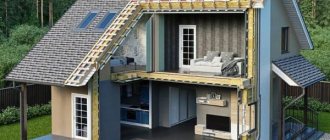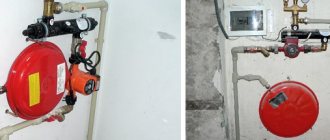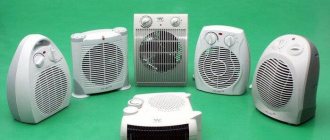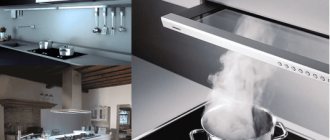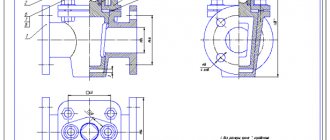Recently, heating systems based on electric convectors have become widespread for heating houses, especially where there is no possibility of connecting mains gas or such connection is very expensive. Compared to heating using the “boiler - water radiators” scheme, heating with electric convectors has undeniable advantages. It is environmentally friendly, it does not require premises for a boiler room or fuel storage, it is easy to install, has low inertia, is reliable and predictable, does not require maintenance, and is much cheaper in terms of equipment and installation costs. The widespread use of heating with electric convectors is hampered by stereotypes that convectors are exclusively auxiliary heaters in addition to the main heating, that they are suitable only for small houses with an area of 80-100 sq.m., that they have the highest energy consumption compared to other types of electric heating, in in particular, compared to heating with an electric boiler.
The electric convector is no longer an auxiliary heater Source home-comfort.ru
Unlike inexpensive convectors with a minimal set of functions, modern convectors are practically different heating devices, the task of which is not just to heat, but to heat wisely. Therefore, on their basis it is possible to install a full-fledged heating system.
Let’s define the terminology of what is considered a full-fledged permanent heating system, and what is simply heating. A complete heating system is:
- possibility of autonomous safe operation for a long time without human presence;
- ease of management, both individual elements of the system and the entire system as a single device, including remotely;
- energy efficiency is a set of devices and technologies that optimize the operation of the heating system to reduce energy consumption while maintaining comfort.
Let's consider the options for using electric convectors and evaluate them according to these criteria.
Heating by convectors with mechanical thermostats
The simplest heating, often used in summer cottages, is inexpensive convectors with a mechanical thermostat. The main capabilities of such convectors are adjusting the temperature with a knob or slider, choosing the operating power - full or half of the nominal value.
This type of convector is suitable for short-term or additional heating to the main heating and cannot be considered as full-fledged for year-round use. Such electric heaters do not use energy-saving technologies, their task is simply to heat, it is risky to leave them unattended (if the heater is an open filament), they operate with large errors of several degrees, each convector must be adjusted separately, and there is no possibility of control via the Internet. The use of GSM or WiFi sockets does not fundamentally change anything, except for the ability to remotely turn on and off an electrical appliance. Installing a room mechanical thermostat that controls several convectors will allow you to set the temperature from one device, but this is the only advantage of such a connection of convectors.
Scheme with a mechanical room thermostat Source home-comfort.ru
Installation of heaters
To mount an electric heater to a wall, perform the following steps:
- Remove the device from packaging
- Turn the heater with its back side and remove the fastenings
- The holder must be leaned against the wall and the location for mounting the device must be marked.
- Using additional tools, install the bracket
- Attach the convector to the bracket
- After installation, you can turn on the heater and set the optimal air temperature.
Heating by convectors with electronic thermostat
If there are several convectors and they are used for a long time, then simply heating is no longer enough. The first step towards energy efficiency is the ability to program temperature settings for weekdays, weekends, nights and daytime hours so that we can work economically when and where we need it in our weekly schedule. To do this, we will replace mechanical thermostats with electronic ones. An electronic thermostat is a thermostat, but with more precise adjustment of the on/off temperature, plus “brains” that allow you to configure the weekly cycle schedule and the main operating modes (comfortable, economical, minimal). Therefore, it is more correct to call an electronic thermostat a control unit.
Rules for choosing a device
When choosing an electric type in-floor convector, the main thing is to evaluate the power and dimensions of the device. It is also advisable to decide on the type of convection, which can be natural and forced.
The choice of water heaters built into the floor requires taking into account many parameters of the functional features of the device.
Main characteristics of the convector
Initially, you need to select the size of the product, the presence of a fan, the material of the housing, fins, and pipes. In addition, you need to pay special attention to other characteristics.
When considering a built-in water-type convector as a home heating device, you should decide on the manufacturer.
Domestic and foreign manufacturers offer heating devices with a wide power range. By choosing this parameter correctly, you will ensure a comfortable room temperature
One of the most important characteristics of a convector is the type of heating system - single-pipe or two-pipe. Connection diameters are not the primary selection criteria, since adapters are available.
Heating system pressure
This is one of the most important indicators of a water device. Any model is suitable for heating a private house, two-story and three-story cottage, since the pressure in the general heating system is usually no higher than 3 bar.
Usually, for installation in multi-storey buildings, it is recommended to install convectors built into the floor, the operating pressure of which is up to 15 Bar
For high-rise apartments, it is necessary to take into account the pressure testing and working pressure. The operating organization should find out these indicators for your home by comparing them with the characteristics of the selected model.
Selecting a coolant option
When choosing the optimal model of an in-floor convector, it is necessary to take into account the type and parameters of the device. Any model is suitable for individual heating, since the owner of the premises can independently set and control the temperature and characteristics of the coolant.
Residents of high-rise buildings will have to adapt to the conditions and indicators of the water that flows in the sewer pipes. In this case, the following factors should be taken into account: temperature, amount of suspensions, Ph, oxygen content, optimal type of device connection.
Heating with convectors controlled via the Internet
We will continue to modernize the system. If the house is not permanently inhabited, then there is a need for remote monitoring and control of convectors via a mobile application. The mobile application is actually an extended heating system control console. In it you can add/remove heating devices, create separate zones, assign convectors to these zones, managing the zone as a separate device, set parameters for temperature conditions and the operating schedule of each device or zone. As a rule, a mobile application, in addition to controlling convectors, has the ability to control other climate control and household appliances - water heaters, ventilation, air conditioning, lighting, etc., becoming the control center of a smart home.
For such intelligent control, convectors must be connected to the Internet.
There are two most common solutions:
1. System based on inverter convectors. Each convector is equipped with an inverter control unit marked digital Inverter. Electrolux convectors of the Transformer System series with replaceable control units are suitable for this. The inverter control unit has all the same functions as the electronic unit, plus two key differences: the presence of a USB connector for installing a WiFi module for wireless communication with a WiFi router and a fundamentally different operating algorithm of the heating element - with automatic change of heating power.
Where are built-in heating systems used?
Floor-mounted convectors are innovative heating equipment that is distinguished by unique characteristics and stylish appearance.
They are recommended to be installed in the following cases:
- In rooms with large window openings , to eliminate the possibility of a draft in the room.
- In small rooms with a lack of free space or in those in which, according to the project design, there should be no unnecessary elements. The devices are built into the floor screed, leaving maximum space free.
- In rooms with high humidity levels, regardless of their purpose. Here their role is to provide a kind of curtain that prevents windows from fogging up.
In order not to be disappointed and avoid losing money, it is recommended to study information about the models you like before purchasing.
A properly selected heating device will definitely meet your expectations and will allow you to significantly save on energy consumption.
Video description
Connecting a convector using a wifi module to the Hommyn mobile application:
Heating system on convectors with inverter control Source home-comfort.ru
2. Convector system with electronic thermostats and central controller. The operation of the convectors is controlled by a controller connected by a cable to a wifi router or GSM module. The convectors are connected to the controller either by wire or by radio signal (in this case, an individual device code is used). Convectors are controlled through a mobile application and through a controller.
Diagram of a heating system with a controller Source home-comfort.ru
The first scheme does not require the purchase of an expensive controller and is more convenient, since you just need to install a small WiFi module in the USB connector and register the device in the mobile application.
The second option is more expensive and more complicated, since you need to purchase not only special thermostats, but also a controller, which must be powered from a 220V network and connected with a LAN cable to a WiFi router, which is not always convenient and aesthetically pleasing when the controller is placed on the wall.
Besides these important differences, there is another key difference. A convector with a mechanical or electronic thermostat from any manufacturer operates in two states: either turned on at rated power or completely turned off. In an inverter convector, the heating power is regulated differently. It changes automatically depending on the difference between the set temperature and the current one, as well as the rate of change of this difference. This principle of proportional-integral control is often used in industrial systems and, when used in household equipment, allows achieving high energy efficiency compared to classic on/off heater power control.
The thing is that any heating device operating on the on/off principle always has a switch-on temperature and a switch-off temperature that differ from the set one. If the convector thermostat is very sensitive, then its on and off cycles will occur with high frequency, that is, in fact, the convector will constantly work, consuming energy, and in addition constantly load the network when turned on. That is why, in order to reduce the frequency of switching on, thermostats are set with a backlash of several degrees. The downside of this is the excessive work of the convector. Let us explain with an example: the temperature in the convector thermostat was set to 23 degrees. The minimum hysteresis (temperature range for turning on and off) is 2 degrees. The thermostat will turn off the convector at a temperature of 24 degrees, and turn it on at a temperature of 22 degrees. Trifle? If this is one convector that is used for several days, yes, it’s a small thing. And if there are 8-10 such convectors and they operate for 7 months of the heating season, then a large amount of electricity is consumed, because every extra degree of overheating is a plus of 5-10% to the heat consumption. And it doesn’t matter whether the convector is controlled by an external room thermostat connected to the controller or weather automation or the convector’s own thermostat. In online stores, the characteristics of a convector often indicate an electronic thermostat with an accuracy of 0.5°C. The nuance is that you can very accurately set the temperature on the electronic thermostat of the convector using buttons (in mechanical convectors this is done by eye), but this does not mean that the convector will accurately maintain the temperature at the set value. If the convector is controlled according to the on/off principle, it will work with a temperature saw around the set value. And the higher the thermostat hysteresis, the higher the excess electricity consumption over a long distance.
Main disadvantages
Let us highlight several main disadvantages of such heaters, which should be clearly understood before purchasing:
- They use electrical elements. For example, a fan helps improve air circulation, but if it gets wet, serious problems will arise and you will have to replace it. And here we would like to point out that only a few fans for such heaters are sold separately. Therefore, in many cases you will have to buy a new heater; replacing a certain element will not work.
- Now there is a large assortment. But, only 120 mm heaters with a built-in fan can really heat the room. The rest will not provide the necessary heat in the room.
- You cannot use such convectors if there is parquet on the floor. This is due to the fact that the parquet begins to expand after heating; accordingly, the protective grille of the heater will be protected and it will not be possible to carry out repairs or check the condition.
Animals' paws can get caught in the grille, which is also considered traumatic
- A floor convector is a real magnet for dust, hair, and dirt. Plus, it is extremely difficult to care for it, since you need to constantly remove the grille and try to get to distant places.
- If the heater starts to leak, very serious problems will arise, since you will have to take out the entire structure and tighten the weak points. Ordinary radiators are easy to tighten and even a fragile girl can cope with such a task.
- When a flood occurs, the neighbors will initially find out about it, and only then the owners. And here it is worth understanding what will happen to all neighbors at once, so you should be very careful with its use.
- The windows will constantly sweat because effective convection is not created. And you need to kill cold air in the weakest place - on the window. Even a small distance from the window to the heat source will lead to fogging and this point should be clearly understood.
Related article: How to make a folding sofa with your own hands
Video description
To find out which is more economical - an inverter heating system or heating using an electric boiler and radiators, see the following video:
Stereotype: Only for small houses
And in conclusion, regarding the prevailing opinion that convectors are only for houses with a small area with the number of heating points no more than 6. The objective disadvantages of a heating system with an electric boiler are characteristic of both small houses of 80-100 sq.m., and houses of a larger area. This means that the disadvantages of one system and the advantages of another are scaled to houses with a larger area of 200-300 sq.m.
Positive and negative qualities of devices
Convectors, like any other equipment, have their pros and cons. Positive qualities include:
- Fast room heating
- Silent operation
- Duration of operation
- Safe Operation
- Affordable prices for convector heaters.
Negative qualities:
- Not suitable for heating large areas
- High electricity consumption. Although there are energy-saving convector heaters for home use.
Several general recommendations for connecting electric convectors.
Installing a heating system on electric convectors does not require any special skills, even if you are not an electrician. General recommendations must be followed:
- Do not place a total load of more than 3 kW on one line (3 convectors of 1 kW each, or 2 of 1.5 kW each)
- Connect such a line through a differential circuit breaker of at least 15A
- When connecting in series to one load line more than 3 kW, use a contactor
- When using a room thermostat or a GSM socket not manufactured by the convectors, pay attention to the permissible current for it
Features of in-floor water devices
The heating element of water heating devices built into the floor is a hollow tube with pressed or welded plates. Heat transfer is carried out by coolant with antifreeze or water. Trench convectors are connected to a common water heating system using threaded pipes.
In built-in water products, the heat exchanger plays an important role. Maximum power is provided by more expensive copper and copper-aluminum heat exchangers. The latter are equipped with a copper pipe and aluminum fins.
Manufacturers also offer budget models made of stainless steel and an economy option made of galvanized steel.
The heat exchangers and inner walls of the body of most models of trench convectors are painted dark. Due to this, they are practically invisible through the decorative grille
Expensive convectors equipped with copper heat exchangers, in addition to the function of increasing the power of the device, have several disadvantages.
Disadvantages of using such models:
- Copper requires special operating conditions. It is not compatible with some metals from which coolant and grounding devices are made.
- Operating models with heat exchangers made of this metal in a central heating system can cause problems.
But they are suitable for individual heating systems where there is wiring with polymer, metal-polymer or copper pipes. It is better if the heat exchanger of the heating boiler is also made of copper.
Fittings and fittings must be chrome-plated, nickel-plated, brass or bronze.
In addition to water ones, manufacturers offer electric built-in convectors. In them, the main role is played by the heating element - the heating element. It contains plates designed to increase the area of contact of the device with air.
These devices serve as an additional source of thermal radiation in rooms where it is not possible to connect water heating.
Inspection before purchase
- It is imperative to inspect the device before purchasing. Damage to the heater cover is unacceptable, and the corners and seams must be smooth and neat.
- Low-quality convectors almost always have flaws in their appearance.
- The higher the convector, the faster it will heat the surrounding air, this should be taken into account.
- Convectors with a body length of 40 cm and above are considered tall.
- Convectors up to 20 cm high, which are usually placed on baseboards, have a low flow rate, so they are produced up to two and a half meters long.
- If you are going to install the convector in a damp room, then you must choose a model with splash protection.
Tip-over indicator
It is important to note that when buying a wall-mounted convector, you should take into account that such models do not have tip-over indicators, which specifically turns off the power supply in this case. So it is better, if you are going to use a floor-standing model, to purchase convectors specially designed for this.
How to choose?
- The main parameters that you will need to follow when buying a convector are the following.
- Convenience and safety of use, efficiency, long-term operation, useful additional functions, and, of course, price. All of them will be determined by the design of the heating device.
- First you need to decide which convector you will need. They are usually placed on walls or under windows.
- If you want the convector to be mobile, then you will need to purchase a special floor-standing model with special legs.

